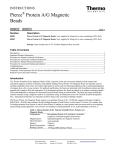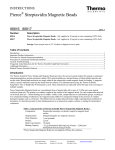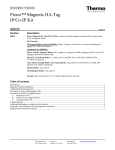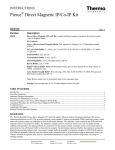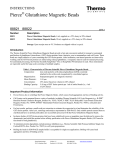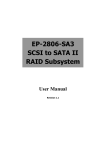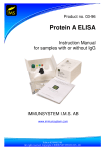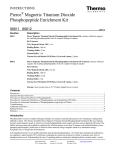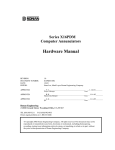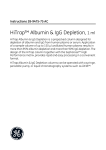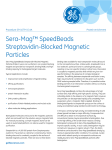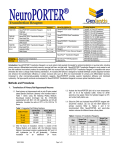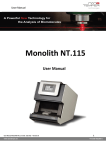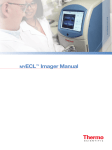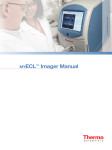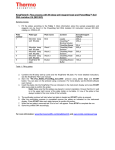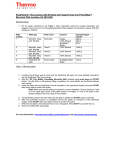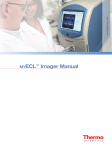Download Pierce™ Protein A/G Magnetic Beads
Transcript
INSTRUCTIONS Pierce™ Protein A/G Magnetic Beads 88802 88803 2339.4 Number Description 88802 Pierce Protein A/G Magnetic Beads, 1mL, supplied at 10mg/mL in water containing 0.05% NaN3 88803 Pierce Protein A/G Magnetic Beads, 5mL, supplied at 10mg/mL in water containing 0.05% NaN3 Storage: Upon receipt store at 4°C. Product shipped with an ice pack. Table of Contents Introduction ................................................................................................................................................................................. 1 Important Product Information .................................................................................................................................................... 2 Procedure for Manual Antibody Purification............................................................................................................................... 2 Procedure for Automated Antibody Purification ......................................................................................................................... 3 Procedure for Manual Immunoprecipitation ................................................................................................................................ 4 Procedure for Automated Immunoprecipitation .......................................................................................................................... 5 Troubleshooting ........................................................................................................................................................................... 6 Additional Information Available on Our Website ...................................................................................................................... 7 Frequently Asked Questions for the KingFisher Instrument ....................................................................................................... 7 Related Thermo Scientific Products ............................................................................................................................................ 7 Introduction The Thermo Scientific™ Pierce™ Magnetic Beads (Table 1) provide a fast and convenient method for both manual and automated magnetic isolation of proteins using affinity binding. Pierce Protein A/G Magnetic Beads are typically used for isolating antibodies from serum, cell culture supernatant or ascites and for immunoprecipitation and co-immunoprecipitation of antigens from cell or tissue extracts. For antibody purification, the beads are incubated with the antibody solution and then magnetically separated from the supernatant. For immunoprecipitation, the beads are added to an antigen-containing sample. The bound antibodies or antigens are dissociated from the beads using an elution buffer. The beads are removed from the solution manually using a magnetic stand or by automation using an instrument such as the Thermo Scientific KingFisher Flex. Automated instruments are especially useful for large-scale screening of multiple samples. The Pierce Protein A/G Magnetic Beads contain a recombinant Protein A/G (~50,500Da; apparent molecular weight by SDSPAGE ~40-45K) that combines the IgG binding domains of both Protein A and Protein G. Protein A/G contains four Fcbinding domains from Protein A and two from Protein G making it a more general and convenient tool for investigating and purifying immunoglobulins. Also, Protein A/G binding to immunoglobulins is not as pH-dependant as Protein A. Table 1. Characteristics of the Thermo Scientific Pierce Protein A/G Magnetic Beads. Composition: Recombinant Protein A/G monolayer covalently coupled to a blocked magnetic bead surface Magnetization: Superparamagnetic (no magnetic memory) Mean Diameter: 1µm (nominal) Density: 2.0g/cm3 Bead Concentration: 10mg/mL Binding Capacity: 55-85µg rabbit IgG/mg of bead Pierce Biotechnology PO Box 117 (815) 968-0747 3747 N. Meridian Road Rockford, lL 61105 USA (815) 968-7316 fax www.thermoscientific.com/pierce Important Product Information • Do not centrifuge, dry or freeze the Pierce Magnetic Beads. Centrifuging, drying or freezing will cause the beads to aggregate and lose binding activity. To ensure good dispersal of beads for optimal antibody binding, it is important to include 0.05% non-ionic (e.g., Tween™-20 Detergent) or zwitterionic (e.g., CHAPS) detergent in the binding buffer and mix the beads during incubation. • To minimize protein degradation, include protease inhibitors (e.g., Thermo Scientific™ Halt™ Protease Inhibitor SingleUse Cocktail, EDTA-free, Product No. 78425) in preparation of cell lysates. • A low-pH elution may be used for single-use applications. Optimal time for low-pH elution is 10 minutes; exceeding 10 minutes may result in nonspecific binding and yield reduction. • When using rabbit antibodies (primary or secondary) in downstream Western blot applications, perform elution in SDSPAGE sample buffer at room temperature. For all other antibody species, boiling the beads in SDS-PAGE sample buffer is acceptable for single-use applications. Boiling could cause bead aggregation and loss of binding activity. • Pierce Protein A/G Magnetic Beads are compatible with small-scale antibody purification and immunoprecipitation and analyses by Western blot and mass spectrometry. • Protein A/G has a broader binding range than either Protein A or Protein G individually. Protein A/G binds to all human IgG subclasses, binds somewhat to IgA, IgE, IgM and, to a lesser extent, IgD. Unlike Protein G, Protein A/G does not bind serum albumin because the gene sequence coding for the albumin-binding site has been eliminated. Protein A/G is effective for mouse monoclonal antibody purification from IgG subclasses because Protein A/G binds all mouse IgG subclasses but does not bind murine IgA, IgM or serum albumin. For more information, see Tech Tip #34: Binding Characteristics for Immunoglobulins and Protein L, A, G and A/G from our website. Procedure for Manual Antibody Purification A. Additional Materials Required • 1.5mL microcentrifuge tubes • Sample: serum, concentrated cell culture supernatant or concentrated ascites Note: Samples can be concentrated using the Pierce Concentrators 20mL/20K, Product No. 87751 or 89887A • Binding/Wash Buffer: Tris-buffered saline (TBS, Product No. 28360) containing 0.05% Tween-20 Detergent • Elution Buffer: IgG Elution Buffer, pH 2.0 (Product No. 21028) or 0.1M glycine, pH 2.0 • Neutralization Buffer: High-ionic strength alkaline buffer such as a 1M phosphate or 1M Tris; pH 7.5-9 • Magnetic stand (e.g., Thermo Scientific™ MagnaBind™ Magnet for 6 × 1.5mL Microcentrifuge Tubes; Product No. 21359) B. Antibody Purification from Serum, Cell Culture Supernatant or Ascites Note: To ensure homogeneity, mix the beads thoroughly before use by repeated inversion, gentle vortexing or using a rotating platform. 1. Place 50µL (0.50mg) of Pierce Protein A/G Magnetic beads into a 1.5mL microcentrifuge tube. Add 150µL of Binding/Wash buffer to the beads and gently vortex to mix. 2. Place the tube into a magnetic stand to collect the beads against the side of the tube. Remove and discard the supernatant. 3. Add 1mL of Binding/Wash Buffer to the tube. Invert the tube several times or gently vortex to mix for 1 minute. Collect beads with magnetic stand, then remove and discard the supernatant. 4. Dilute 10µL of sample with 490µL Binding/Wash Buffer. Note: Sample volume can be modified according to user preference. If the sample volume is < 500µL, dilute it to a final volume of 500µL with Binding/Wash Buffer. 5. Add the diluted sample to the tube containing pre-washed magnetic beads and gently vortex or invert to mix. 6. Incubate the samples at room temperature with mixing for 1 hour. 7. Collect the beads with a magnetic stand, then remove and discard the supernatant. Pierce Biotechnology PO Box 117 (815) 968-0747 3747 N. Meridian Road Rockford, lL 61105 USA (815) 968-7316 fax 2 www.thermoscientific.com/pierce 8. Add 500µL of Binding/Wash Buffer to the tube, mix well, collect the beads with a magnetic stand and discard the supernatant. Repeat this wash twice. 9. Add 100µL of Elution Buffer to the tube, mix well and incubate 10 minutes at room temperature with occasional mixing. 10. Collect the beads with a magnetic stand and then remove and save the supernatant that contains the eluted antibody. To neutralize the low pH, add 10µL of Neutralization Buffer for each 100µL of eluate. Note: 50µL is the minimum volume of beads recommended for antibody purification. Procedure for Automated Antibody Purification A. Additional Materials Required • KingFisher Flex with 96 deep well head (Product No. 5400630) • Microtiter Deep well 96 Plate, V-bottom, polypropylene (100-1000µL; Product No. 95040450) • KingFisher Flex 96 Tip Comb for Deep Well Magnets (Product No. 97002534) • Binding/Wash Buffer: Tris-buffered saline (TBS, Product No. 28360) containing 0.05% Tween-20 Detergent • Elution Buffer: IgG Elution Buffer, pH 2.0 (Product No. 21028) or 0.1M glycine, pH 2.0 • Neutralization Buffer: High-ionic strength alkaline buffer such as a 1M phosphate or 1M Tris; pH 7.5-9 B. Preparation of Instrument and Plate Set-up Note: The following protocol is designed for general use with the KingFisher Flex Instrument. The protocol can be modified according to customer needs using the Thermo Scientific™ BindIt™ Software provided with the instrument. 1. Download the “Antibody Purification” protocol from the Thermo Fisher Scientific website (http://www.thermoscientific.com/bindit-protocols) into the BindIt Software on an external computer. 2. Transfer the protocol to the KingFisher Flex from an external computer. See BindIt Software User Manual for detailed instructions on importing protocols. 3. Set up the plates according to Table 2. Table 2. Pipetting instructions for the antibody purification protocol using the Microtiter Deep Well 96 Plates. Plate # Plate Name Content Volume Protein A/G beads 50µL 1 Beads Binding/Wash Buffer 150µL 2 Bead Wash Binding/Wash Buffer 1000µL Sample 10µL 3 Bind Binding/Wash Buffer 490µL 4 Wash 1 Binding/Wash Buffer 500µL 5 Wash 2 Binding/Wash Buffer 500µL 6 Wash 3 Water 500µL 7 Elution Elution Buffer 100µL 8 Tip Plate KingFisher Flex 96 Tip Comb for Deep Well Magnets - Notes: • • • • If using less than 96 wells, fill the same wells in each plate. For example, if using wells A1 through A12, use these same wells in all plates. To ensure bead homogeneity, mix the vial thoroughly by repeated inversion, gentle vortexing or rotating platform before adding the beads to plate 1. Combine the Tip Comb with a Deep Well 96 Plate. See KingFisher Flex Instrument user manual for detailed instructions. Sample volume can be modified according to user preference. If the sample volume is < 500µL dilute it to a final volume of 500µL with Binding/Wash Buffer. Pierce Biotechnology PO Box 117 (815) 968-0747 3747 N. Meridian Road Rockford, lL 61105 USA (815) 968-7316 fax 3 www.thermoscientific.com/pierce C. Executing the Antibody Purification Protocol on the KingFisher Flex 1. Select the protocol using the arrows on the instrument keypad and press Start. See KingFisher Flex User Manual for detailed information. 2. Slide open the door of the instrument’s protective cover. 3. Load the plates into the KingFisher Flex according to the protocol request, placing each plate in the same orientation. Confirm each action by pressing Start. 4. After sample processing, remove plates as instructed by the instrument’s display. Press Start after removing each plate. 5. Press Stop after all plates are removed. Upon completion, if desired, neutralize the low pH by adding 15µL of Neutralization Buffer for each 100µL of eluate. Procedure for Manual Immunoprecipitation A. Additional Materials Required • 1.5mL microcentrifuge tubes • Wash Buffer: Tris-buffered saline (TBS, Product No. 28360) containing 0.05% Tween-20 Detergent and 0.5M NaCl • Low pH Elution Buffer: IgG Elution Buffer, pH 2.0 (Product No. 21028) or 0.1M glycine, pH 2.0 • Alternative Elution Buffer: SDS-PAGE reducing sample buffer • Antibody for immunoprecipitation • Antigen Sample • Cell Lysis Buffer (used to adjust IP reaction volume) • Neutralization Buffer: High-ionic strength alkaline buffer such as a 1M phosphate or 1M Tris; pH 7.5-9 • Magnetic stand (e.g., MagnaBind Magnet for 6 × 1.5mL Microcentrifuge Tubes, Product No. 21359) B. Immunoprecipitation Note: This protocol is a general guideline for immunoprecipitation and will require optimization for each application. 1. Combine the antigen sample with 10µg of antibody. Adjust the reaction volume to 500µL with the Cell Lysis Buffer. Incubate the reaction for 1-2 hours at room temperature or overnight at 4ºC with mixing. 2. Place 25µL (0.25mg) of Pierce Protein A/G Magnetic Beads into a 1.5mL microcentrifuge tube. 3. Add 175µL of Wash Buffer to the beads and gently vortex to mix. 4. Place the tube into a magnetic stand to collect the beads against the side of the tube. Remove and discard the supernatant 5. Add 1mL of Wash Buffer to the tube. Invert the tube several times or gently vortex to mix for 1 minute. Collect beads with magnetic stand. Remove and discard the supernatant. 6. Add the antigen sample/antibody mixture to a 1.5mL microcentrifuge tube containing pre-washed magnetic beads and incubate at room temperature for 1 hour with mixing. 7. Collect the beads with a magnetic stand and then remove the flow-through and save for analysis. 8. Add 500µL of Wash Buffer to the tube and gently mix. Collect the beads and discard the supernatant. Repeat wash twice. 9. Add 500µL of purified water to the tube and gently mix. Collect the beads on a magnetic stand and discard the supernatant. 10. Low-pH Elution: Add 100µL of Low-pH Elution Buffer to the tube. Incubate the tube at room temperature with mixing for 10 minutes. Magnetically separate the beads and save the supernatant containing target antigen. To neutralize the low pH, add 15µL of Neutralization Buffer for each 100µL of eluate. Alternative Elution: Add 100µL of SDS-PAGE reducing sample buffer to the tube and heat the samples at 96-100ºC in a heating block for 10 minutes. Magnetically separate the beads and save the supernatant containing target antigen. Note: If you will be performing a Western blot using rabbit antibodies (primary or secondary) do not heat the samples. Incubate at room temperature for 10 minutes with mixing. Pierce Biotechnology PO Box 117 (815) 968-0747 3747 N. Meridian Road Rockford, lL 61105 USA (815) 968-7316 fax 4 www.thermoscientific.com/pierce Procedure for Automated Immunoprecipitation A. Additional Materials Required • KingFisher Flex with 96 deep well head (Product No. 5400630) • Microtiter Deep Well 96 Plate, V-bottom, polypropylene (100-1000µL; Product No. 95040450) • KingFisher Flex 96 Tip Comb for Deep Well Magnets (Product No. 97002534) • 1.5mL microcentrifuge tubes • Binding Buffer: Tris-buffered saline (TBS, Product No. 28360) containing 0.05% Tween-20 Detergent • Wash Buffer: Tris-buffered saline (TBS, Product No. 28360) containing 0.05% Tween-20 Detergent and 0.5M NaCl • Low pH Elution Buffer: IgG Elution Buffer, pH 2.0 (Product No. 21028) or 0.1M glycine, pH 2.0 • Alternative Elution Buffer: SDS-PAGE reducing sample buffer • Antibody for immunoprecipitation • Antigen Sample • Cell Lysis Buffer (used to prepare the antigen sample) • Neutralization Buffer: High-ionic strength alkaline buffer such as a 1M phosphate or 1M Tris; pH 7.5-9) B. Instrument Preparation and Plate Set-up Note: The following protocol is designed for general use with the KingFisher Flex Instrument. The protocol can be modified according to your needs using the BindIt Software provided with the instrument. 1. Combine antigen sample with 2-10µg of immunoprecipitation antibody per sample. Incubate 1-2 hours at room temperature or overnight at 4ºC with mixing. 2. Download the “Immunoprecipitation” protocol from the Thermo Fisher Scientific website (http://www.thermoscientific.com/bindit-protocols) into the BindIt Software on an external computer. 3. Transfer the protocol to the KingFisher Flex from an external computer. See BindIt Software User Manual for detailed instructions on importing protocols. 4. Set up plates according to Table 3. Table 3. Pipetting instructions for the immunoprecipitation protocol using the Microtiter Deep Well 96 Plates. Plate # Plate Name Content Volume Time/Speed Protein A/G Beads 25µL 1 Beads 5 seconds Binding Buffer 175µL 2 Bead Wash Binding Buffer 1 minute/Slow 1000µL Antibody/Antigen 3 Bind 1 hour/Slow 500µL Sample 4 Wash 1 Wash Buffer 30 seconds/Slow 500µL 5 Wash 2 Wash Buffer 30 seconds/Slow 500µL 6 Wash 3 Ultrapure Water 30 seconds/Slow 500µL 7 Elution Elution Buffer 10 minutes/ Medium 100µL KingFisher Flex 96 Tip Comb for Deep 10 seconds/Fast 8 Tip Plate Well Magnets Pierce Biotechnology PO Box 117 (815) 968-0747 3747 N. Meridian Road Rockford, lL 61105 USA (815) 968-7316 fax 5 www.thermoscientific.com/pierce Notes: • If less than 96 wells are used, fill the same wells in each plate. For example, if using wells A1 through A12, use these same wells in all plates. • To ensure bead homogeneity, mix the vial thoroughly by repeated inversion, gentle vortexing, or rotating platform before adding the beads to Plate 1. Combine the Tip Comb with a Deep Well 96 Plate. See the instrument user manual for detailed instructions. • • The beads can be eluted into 100µL of 0.1M glycine, pH 2-3 or 100µL of SDS-PAGE reducing sample buffer. If using SDS-PAGE reducing sample buffer in a heated elution, install the KingFisher Flex Heating Block (see manual for proper installation) to heat samples at 96-100ºC for 10 minutes. • If you select SDS-PAGE reducing sample buffer for elution and will be performing a Western blot using rabbit antibodies (primary or secondary) do not heat the samples. Incubate at room temperature for 10 minutes. • If low-pH elution buffer is selected for elution, neutralize the pH using 15µL Neutralization Buffer for each 100µL of eluate upon run completion. • To limit evaporation, select “Mix” and “Slow” speed under the subheading “Heating Action.” C. Executing Automated Immunoprecipitation Protocol 1. Select the protocol using the arrow keys on the instrument keypad and press Start. See the KingFisher Flex Instrument User Manual for detailed information. 2. Slide open the door of the instrument’s protective cover. 3. Load plates into the instrument according to the protocol request, placing each plate in the same orientation. Confirm each action by pressing Start. 4. After the samples are processed, remove the plates as instructed by the instrument’s display. Press Start after removing each plate. Press Stop after all the plates are removed. Troubleshooting Problem Low amount of protein was recovered Possible Cause The protein degraded Not enough magnetic beads were used Protein does not elute Sample had an insufficient amount of target protein Elution conditions were too mild Bands at ~50kDa appeared on the Western blot Multiple nonspecific bands Recovered protein was inactive Magnetic beads aggregated Elution was performed in Lane Marker Sample Buffer at temperatures above room temperature and rabbit antibody was used in the Western blot detection Nonspecific protein bound to the magnetic beads Elution conditions were too stringent Magnetic beads were frozen or centrifuged Buffer was incompatible with magnetic beads Solution Add protease inhibitors Increase the amount of magnetic bead used for capture Increase amount of antigen sample Increase incubation time with elution buffer or use more stringent elution buffer Perform elution at room temperature when using a rabbit antibody for Western blot detection Add 50-350mM of NaCl to the Binding/Wash and Elution Buffers Use a milder elution buffer (e.g., Thermo Scientific™ Gentle Elution Buffer, Product No. 21034) Handle the beads as directed in the instructions Pierce Biotechnology PO Box 117 (815) 968-0747 3747 N. Meridian Road Rockford, lL 61105 USA (815) 968-7316 fax 6 www.thermoscientific.com/pierce Additional Information Available on Our Website • Frequently Asked Questions • Tech Tip #43: Protein stability and storage • Tech Tip #34: Binding characteristics for immunoglobulins and Protein L, A, G and A/G • Visit www.thermoscientific.com/kingfisher for information on the KingFisher Products • In the U.S.A., purchase KingFisher Supplies from Fisher Scientific. Contact your local Thermo Fisher Scientific office to purchase KingFisher Supplies outside the U.S.A. Frequently Asked Questions for the KingFisher Instrument Question Which plates are compatible with KingFisher Flex Instrument? Answer The KingFisher Flex Instrument is compatible with the KingFisher 24 Deep Well Plates, Microtiter Deep Well 96 Plates, KingFisher 96 and 96 PCR Plates Is it possible to concentrate samples during the run? Both deep-well plates and KingFisher 96 Plates can be used during the same run. Therefore, it is possible to start the processing using larger volumes (in a deep well plate) and elute the purified sample to a smaller volume (in a KingFisher 96 Plate) Is it possible to heat the samples during the run? The heating block is located inside the instrument and can be used automatically during the sample process. All plates compatible with the KingFisher Flex Instrument can be heated using specially designed, interchangeable heating blocks Why do the beads stick to the plastic tips and wells or the eluted protein sticks to the wells? Proteins conjugate to beads and eluted proteins can nonspecifically bind to plastics. Adding detergent to Binding/Wash Buffer prevents the protein conjugated to the bead from sticking (0.05%-0.1% Tween-20 Detergent). Also include a small amount of detergent in the elution buffer (e.g., 0.05% Tween-20 Detergent) or silanize the elution plate Are the reagent volumes in each well critical? For best results, keep the specified volumes within defined limits to avoid spillover Related Thermo Scientific Products 88804 Pierce Classic Magnetic IP/Co-IP Kit 88805 Pierce Crosslink Magnetic IP/Co-IP Kit 88845-6 Pierce Protein A Magnetic Beads 88847-8 Pierce Protein G Magnetic Beads 88849-50 Pierce Protein L Magnetic Beads 88816-7 Pierce Streptavidin Magnetic Beads 88826-7 Pierce NHS-Activated Magnetic Beads 88828 Pierce Direct Magnetic IP/Co-IP Kit 24615 Imperial™ Protein Stain, 1L 34075 SuperSignal™ West Dura Extended Duration Substrate 25200-44 Precise Gels, see catalog or website for a complete listing Pierce Biotechnology PO Box 117 (815) 968-0747 3747 N. Meridian Road Rockford, lL 61105 USA (815) 968-7316 fax 7 www.thermoscientific.com/pierce Products are warranted to operate or perform substantially in conformance with published Product specifications in effect at the time of sale, as set forth in the Product documentation, specifications and/or accompanying package inserts (“Documentation”). No claim of suitability for use in applications regulated by FDA is made. The warranty provided herein is valid only when used by properly trained individuals. Unless otherwise stated in the Documentation, this warranty is limited to one year from date of shipment when the Product is subjected to normal, proper and intended usage. This warranty does not extend to anyone other than Buyer. Any model or sample furnished to Buyer is merely illustrative of the general type and quality of goods and does not represent that any Product will conform to such model or sample. NO OTHER WARRANTIES, EXPRESS OR IMPLIED, ARE GRANTED, INCLUDING WITHOUT LIMITATION, IMPLIED WARRANTIES OF MERCHANTABILITY, FITNESS FOR ANY PARTICULAR PURPOSE, OR NON INFRINGEMENT. BUYER’S EXCLUSIVE REMEDY FOR NONCONFORMING PRODUCTS DURING THE WARRANTY PERIOD IS LIMITED TO REPAIR, REPLACEMENT OF OR REFUND FOR THE NONCONFORMING PRODUCT(S) AT SELLER’S SOLE OPTION. THERE IS NO OBLIGATION TO REPAIR, REPLACE OR REFUND FOR PRODUCTS AS THE RESULT OF (I) ACCIDENT, DISASTER OR EVENT OF FORCE MAJEURE, (II) MISUSE, FAULT OR NEGLIGENCE OF OR BY BUYER, (III) USE OF THE PRODUCTS IN A MANNER FOR WHICH THEY WERE NOT DESIGNED, OR (IV) IMPROPER STORAGE AND HANDLING OF THE PRODUCTS. Unless otherwise expressly stated on the Product or in the documentation accompanying the Product, the Product is intended for research only and is not to be used for any other purpose, including without limitation, unauthorized commercial uses, in vitro diagnostic uses, ex vivo or in vivo therapeutic uses, or any type of consumption by or application to humans or animals. Current product instructions are available at www.thermoscientific.com/pierce. For a faxed copy, call 800-874-3723 or contact your local distributor. © 2013 Thermo Fisher Scientific Inc. All rights reserved. Tween is a trademark of Croda International PLC. All (other) trademarks are the property of Thermo Fisher Scientific Inc. and its subsidiaries. Printed in the USA. Pierce Biotechnology PO Box 117 (815) 968-0747 3747 N. Meridian Road Rockford, lL 61105 USA (815) 968-7316 fax 8 www.thermoscientific.com/pierce








